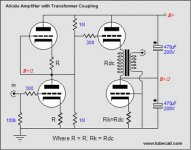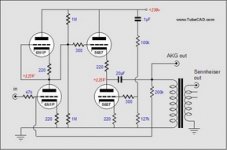aikido and output transformer
I am thinking of building one of this: http://www.tubecad.com/2006/04/27/aikido_high_impedance_headphone_amplifier.png
I am wondering if the output caps can be omitted if I use an output transformer.
Thanks for the help.
I am thinking of building one of this: http://www.tubecad.com/2006/04/27/aikido_high_impedance_headphone_amplifier.png
I am wondering if the output caps can be omitted if I use an output transformer.
Thanks for the help.
Re: aikido and output transformer
Yes. Proponents of iron for DC blocking claim fine iron beats the sound of fine caps. Can't verify that position yet but I plan to try it out with my Aikido boards.
jarthel said:I am wondering if the output caps can be omitted if I use an output transformer.
Yes. Proponents of iron for DC blocking claim fine iron beats the sound of fine caps. Can't verify that position yet but I plan to try it out with my Aikido boards.
Re: Re: aikido and output transformer
can you suggest an output transformer from the hammond range that is suitable for the aikido headphone amp? thank you
leadbelly said:
Yes. Proponents of iron for DC blocking claim fine iron beats the sound of fine caps. Can't verify that position yet but I plan to try it out with my Aikido boards.
can you suggest an output transformer from the hammond range that is suitable for the aikido headphone amp? thank you
Requires an airgapped OPT, so Im not sure low end iron will beat capacitor coupling of similar cost. Consider using oil motor run capacitors for budget coupling caps as another alternative. From correspondence:
Attachments
Thanks for correcting me. I was thinking of the attached schematic and thought that the capacitor was only needed for DC blocking for the High-Z output. I also thought non-airgapped transformers were suitable for this service if the DC current was low enough, but it sounds like that's not the case. 
Attachments
Geek said:*cough*Edcor*cough*
You guys are confusing the bleep out of me. Why would you put in a 1:1 transformer if you still need the cap to block DC? I could see using the 10K/150 or 10K/600 to drive low-Z headphones.
I can´t do the math, but to my eye the circuit first published would seem to work nicely with a Lundahl 1660SE/18mA. Is there something that would make this a bad choice in the Aikido output stage?
Edit: and the second one would do witout a coupling cap, if you don't need the high z output.
Edit: and the second one would do witout a coupling cap, if you don't need the high z output.
zix said:Edit: and the second one would do witout a coupling cap, if you don't need the high z output.
Yeah, I'm having a tough time deciding between (1) the low-Z version built of the 1st post with 6H30 and an ouput cap, and (2) the schematic I posted built with the Edcor 10K:150 transformer and no output cap. Cost is comparable between those 2 options.
Tweeker said:Requires an airgapped OPT, so Im not sure low end iron will beat capacitor coupling of similar cost. Consider using oil motor run capacitors for budget coupling caps as another alternative. From correspondence:
Hi Tweeker,
I read your circuit with great interests, as I am thinking of applying output transformer at the Aikido circuit too. It appears that I haven't seen this before at the www.tubecad.com, isn't it?
Have you tried it yet?
I observe that the later part is quite unique. e.g. the secondary of the transformer is connected to the grid of the bottom tube and then tied to ground; the two equal capacitors is tied to the plate of the bottom tube. Can I use a lower value? How to figure them out?
Can I use a 1:1, 2:1 or 4:1 transformer here?
Can you elaborate more?
Thanks.
Regards,
T.C. MA
Re: Re: aikido and output transformer
well, we know that transformers beat coupling caps when it comes to MC stages, but that is a bit of a cheat in terms of direct comparison, as the tranny is used in a multiplier situation. some will debate that, but I don't personally think there is all that much to compare, until you get to extreme capacitor quality. then a comparison can take place. then the tranny is still debatably better, to the human ear, in terms of harm to the signal. Resuts vary.
leadbelly said:
Yes. Proponents of iron for DC blocking claim fine iron beats the sound of fine caps. Can't verify that position yet but I plan to try it out with my Aikido boards.
well, we know that transformers beat coupling caps when it comes to MC stages, but that is a bit of a cheat in terms of direct comparison, as the tranny is used in a multiplier situation. some will debate that, but I don't personally think there is all that much to compare, until you get to extreme capacitor quality. then a comparison can take place. then the tranny is still debatably better, to the human ear, in terms of harm to the signal. Resuts vary.
The circuit came from John Broskie, though it does not appear on his site. If I used a xfmr Id certainly take advantage of the chance to gear down a bit to something more optimal for my tube and output choices.
The 470uF capacitors are filter caps on the B+, they could be of different value, though they should both be the same and bleeders may be wise.
The 470uF capacitors are filter caps on the B+, they could be of different value, though they should both be the same and bleeders may be wise.
Tweeker said:The circuit came from John Broskie, though it does not appear on his site. If I used a xfmr Id certainly take advantage of the chance to gear down a bit to something more optimal for my tube and output choices.
The 470uF capacitors are filter caps on the B+, they could be of different value, though they should both be the same and bleeders may be wise.
Hi Tweeter,
Thanks for your reply. I want to try a 2:1 or 4:1 transformer in the circuit.
Regards,
T.C. MA
leadbelly said:
Yeah, I'm having a tough time deciding between (1) the low-Z version built of the 1st post with 6H30 and an ouput cap, and (2) the schematic I posted built with the Edcor 10K:150 transformer and no output cap. Cost is comparable between those 2 options.
If using the edcor 10K:150, is the:
a. CT on the output side goes to ground
b. audio signal output is from either one of the 150ohm leads
Is this correct?
jarthel said:If using the edcor 10K:150, is the:
a. CT on the output side goes to ground
b. audio signal output is from either one of the 150ohm leads
Is this correct?
No, one end goes to ground and the headphone negative, the other end goes to headphone positive; the center tap unconnected. Since you are trying to build the high-Z version (high-Z cans?), you shouldn't be using the 10k:150, you should be using the 600:600 model Geek pointed out.
since hammond is easily available locally,
can i use something like this? http://www.hammondmfg.com/collins.htm
using the hammond, is the output connection still the same?
1. one of the 8ohm (maybe it's labelled as 0ohm on the hammond site but I can't clearly see it) lugs goes signal ground and headphone ground
2. the other 8ohm lug goes to the headphone right (or left channel)
is this correct?
thanks again
can i use something like this? http://www.hammondmfg.com/collins.htm
using the hammond, is the output connection still the same?
1. one of the 8ohm (maybe it's labelled as 0ohm on the hammond site but I can't clearly see it) lugs goes signal ground and headphone ground
2. the other 8ohm lug goes to the headphone right (or left channel)
is this correct?
thanks again
I'm sort of lost as to what you are trying to achieve. If you plan on using this transformer, you obviously don't have high-Z cans. Why wouldn't you just build the low-Z version of the Aikido amp, it's roughly the same parts and cost? This transformer doesn't look so good, if you use the 8 ohm taps with 32 ohm cans, then the tubes are driving against 2400 ohms, whereas Broskie has biased them to drive 600 ohm cans.
- Status
- This old topic is closed. If you want to reopen this topic, contact a moderator using the "Report Post" button.
- Home
- Amplifiers
- Tubes / Valves
- Aikido and output transformer

